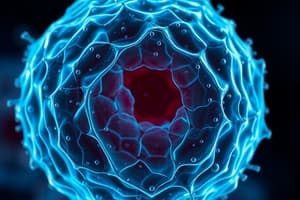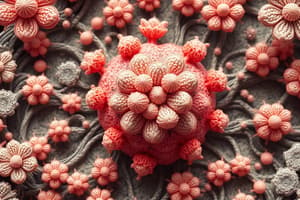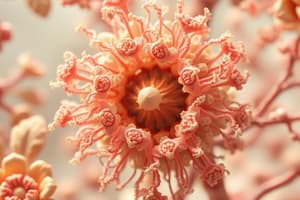Podcast
Questions and Answers
What primarily causes atrophy in cells?
What primarily causes atrophy in cells?
- Improved blood supply
- Increased protein synthesis
- Enhanced cell division
- Decreased metabolic activity (correct)
Which organ is an example of physiological atrophy?
Which organ is an example of physiological atrophy?
- Thymus gland (correct)
- Pancreas
- Liver
- Kidney
What is a common cause of pathological atrophy of disuse?
What is a common cause of pathological atrophy of disuse?
- Hormonal stimulation
- Immobilization of a limb (correct)
- Improper nutrition
- Excessive exercise
What is the term for the replacement of one differentiated cell type by another?
What is the term for the replacement of one differentiated cell type by another?
Which condition is associated with squamous metaplasia?
Which condition is associated with squamous metaplasia?
What type of metaplasia involves the transformation from muscle to bone?
What type of metaplasia involves the transformation from muscle to bone?
Which of the following is NOT a cause of pathological atrophy?
Which of the following is NOT a cause of pathological atrophy?
What occurs during metaplasia in a cellular context?
What occurs during metaplasia in a cellular context?
What is the primary definition of cellular adaptations?
What is the primary definition of cellular adaptations?
What does hypertrophy refer to in cellular adaptations?
What does hypertrophy refer to in cellular adaptations?
Which adaptation occurs as a response to increased functional demand?
Which adaptation occurs as a response to increased functional demand?
Which type of cellular adaptation involves cell shrinkage?
Which type of cellular adaptation involves cell shrinkage?
What is the effect of hypertrophy on the number of cells?
What is the effect of hypertrophy on the number of cells?
Which of the following best describes pathologic adaptations?
Which of the following best describes pathologic adaptations?
In which scenario would hyperplasia commonly occur?
In which scenario would hyperplasia commonly occur?
Which process may occur alongside hypertrophy in certain conditions like pregnancy?
Which process may occur alongside hypertrophy in certain conditions like pregnancy?
What occurs during hypertrophy of the uterus during pregnancy?
What occurs during hypertrophy of the uterus during pregnancy?
What is one example of pathologic hypertrophy?
What is one example of pathologic hypertrophy?
What characterizes hyperplasia?
What characterizes hyperplasia?
What triggers hormonal hyperplasia in the female breast?
What triggers hormonal hyperplasia in the female breast?
What is a common cause of pathologic hyperplasia?
What is a common cause of pathologic hyperplasia?
How does compensatory hyperplasia occur?
How does compensatory hyperplasia occur?
What does atrophy refer to?
What does atrophy refer to?
What is one physiologic cause of hyperplasia?
What is one physiologic cause of hyperplasia?
What is the metaplastic change observed in the respiratory tract due to smoking?
What is the metaplastic change observed in the respiratory tract due to smoking?
Which type of cell injury is characterized by structural alterations that can be corrected if the damaging stimulus is removed?
Which type of cell injury is characterized by structural alterations that can be corrected if the damaging stimulus is removed?
What is the main cause of hypoxia leading to cell injury?
What is the main cause of hypoxia leading to cell injury?
Which of the following is NOT an etiology of cell injury?
Which of the following is NOT an etiology of cell injury?
What happens to muscle cells at a fracture site?
What happens to muscle cells at a fracture site?
What defines irreversible cell injury?
What defines irreversible cell injury?
Which type of cellular adaptation involves an increase in the number of cells?
Which type of cellular adaptation involves an increase in the number of cells?
What type of metaplasia occurs in the lower esophagus due to chronic acid reflux?
What type of metaplasia occurs in the lower esophagus due to chronic acid reflux?
Study Notes
Cellular Adaptations
- Cellular adaptations are reversible changes in cell structure and function in response to environmental changes.
- Physiologic adaptations result from normal hormonal or chemical stimulation.
- Pathologic adaptations are responses to stress that help cells survive injury.
Hypertrophy
- Hypertrophy is an increase in cell size, resulting in increased organ size.
- It occurs due to increased production of cellular components.
- Occurs in cells incapable of dividing, such as muscle cells and nerve cells.
- Can be physiologic (e.g., muscle hypertrophy in bodybuilders) or pathologic (e.g., left ventricular hypertrophy in hypertension).
Hyperplasia
- Hyperplasia is an increase in cell number, resulting in increased organ size.
- It is usually caused by hormonal stimulation or increased demand.
- Occurs in cells capable of dividing.
- Mechanisms include growth factor-driven proliferation or stem cell-driven new cell production.
- Examples of physiologic hyperplasia: breast enlargement during pregnancy (hormonal) and liver regeneration after partial removal (compensatory).
- Examples of pathologic hyperplasia: endometrial hyperplasia due to excess estrogen and benign prostatic hyperplasia due to excess androgens.
Atrophy
- Atrophy is a decrease in cell size or number, resulting in decreased organ size.
- Results from decreased protein synthesis and increased protein degradation.
- Occurs due to disuse, loss of innervation, diminished blood supply, inadequate nutrition, or pressure.
- Examples: disuse atrophy of immobilized limbs, denervation atrophy in muscles lacking nerve stimulation, pressure atrophy around tumors.
Metaplasia
- Metaplasia is a reversible change where one cell type is replaced by another, usually due to chronic injury or irritation.
- It is driven by reprogramming of tissue stem cells or migration from an adjacent site.
- Examples: squamous metaplasia in respiratory tract due to smoking, columnar metaplasia in esophagus due to chronic reflux.
Cell Injury
- Cell injury is the effect of various stresses on cells, leading to changes in internal and external environments.
- Reversible cell injury involves functional and structural alterations that can be corrected if the stress is removed.
- Irreversible cell injury leads to cell death.
Etiology of Cell Injury
- Hypoxia and ischemia are major causes of cell injury, due to oxygen deficiency.
- Other causes include physical agents (e.g., trauma), chemical agents and drugs, microbial agents, immunologic reactions, nutritional derangements, aging, psychogenic factors, iatrogenic factors, and genetic causes.
Studying That Suits You
Use AI to generate personalized quizzes and flashcards to suit your learning preferences.
Related Documents
Description
This quiz covers the essential concepts of cellular adaptations, including hypertrophy and hyperplasia. You will learn about the mechanisms behind these processes and their physiological and pathological implications. Test your understanding of how cells adapt to changes in their environment.




